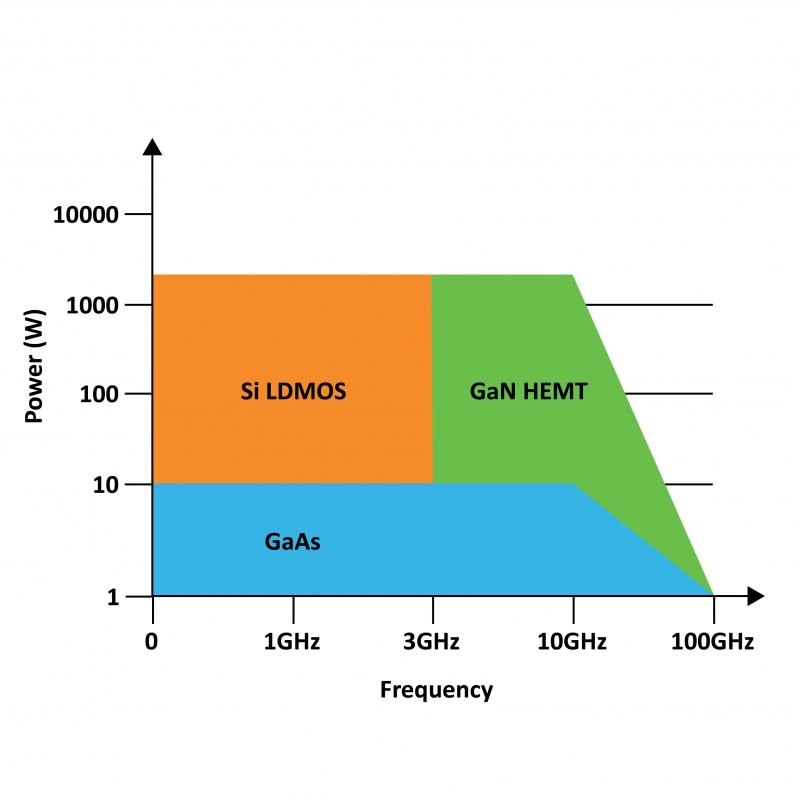GaN Shines Brightly, But It’s Not the Only Star
Like Gallium Arsenide (GaAs) and laterally diffused metal-oxide-semiconductor (LDMOS) before it, Gallium Nitride (GaN) is a revolutionary technology playing an outsize role in enabling the RF, microwave, and millimeter-wave systems of the future. Yet it’s not a panacea and other technologies still have important roles to play.
When Gallium Nitride (GaN) RF power transistors were thrust into service to counter-IED jammers in Iraq and Afghanistan in the mid-2000s the technology was in its infancy. Today GaN discrete devices and monolithic microwave integrated circuit MMICs are formidable competitors to Gallium Arsenide (GaAs) in markets from defense to satellite communications and 5G. And for good reason, because thanks to its extremely high-power density, GaN can produce more RF power in a given amount of die area than any other semiconductor technology used for RF power generation. It can also operate at five times higher voltage and twice the current of GaAs devices with higher power-added efficiency above 10 GHz and operate at higher temperatures.
So, does this mean GaN will replace GaAs in every application? The answer is no, which is why Microchip manufactures discrete and GaN and GaAs MMIC products and has one of the broadest ranges of RF semiconductor products in the industry, from low noise amplifiers to front end modules, RF diodes, switches, voltage-variable attenuators, SAW and MEMS oscillators and integrated modules that combine microcontrollers with RF transceivers (Wi-Fi® MCUs).
To understand where all these technologies are best suited, it’s important to illustrate the strengths of each one. For example, GaAs remains the most versatile semiconductor material as it’s used in applications from power amplifiers to mixers, switches, attenuators, modulators, and current limiters, as well as solar cells, laser diodes, and LEDs. Without GaAs, some applications would not have been achievable.
It was responsible for modernizing active phased-array radars beginning in the late 1980s and has arguably made smartphones and other connected devices possible. GaAs devices are also used in cable system distribution amplifiers, microwave point-to-point links, and many other RF applications up to 90 GHz. However, although relatively high-power amplifier modules can be built using GaAs, GaN requires far fewer of them to achieve much higher RF output powers that will continue to increase in the coming years.
In fairness, it’s important to note that LDMOS technology has also advanced over time and has the benefit of being extremely rugged, with some discrete LDMOS transistors able to operate into an impedance mismatch greater than 65:1 without degradation or damage, while GaN and GaAs are currently limited to about 20:1. They can also produce RF output power up to nearly 2 kW. However, their frequency is limited to about 4 GHz, so while they remain a key RF power generation for years to come in L-and S-band radars, broadcast transmitters, and medical imaging systems, industrial heating and drying, they will ultimately be overtaken by GaN that can operate far into the millimeter-wave region.

As noted earlier, one of GaN’s greatest strengths is its very high-power density, which allows it to generate very high RF power levels with a much smaller gate periphery than can silicon or GaAs. This translates into the ability to produce a truly astonishing amount of RF power from a very small device, which makes GaN well suited for the next generation of active electronically-steered array (AESA) radars and many other applications. And the potential of GaN is just now being realized, so in the future, power density of at least 20 W/mm should be achievable.
Of course, this depends on how quickly and effectively heat can be dissipated from the die outward through the substrate and beyond to heat spreaders, heat sinks, and possibly an external cooling subsystem. While silicon carbide (SiC) substrates are currently the norm, it’s likely that diamond or aluminum-diamond metal matrix composites will become more common, as diamond has the highest thermal conductivity of any material on earth.
Like GaAs and LDMOS before it, GAN is a revolutionary technology playing an outsize role in enabling the RF, microwave, and millimeter-wave systems of the future. But it’s not a panacea, and GaAs will remain a key technology for many, many years. This fact has not been lost on Microchip, demonstrated by its commitment to optimizing the performance of GaAs while also expanding its GaN portfolio in the future.
If you’re not familiar with Microchip’s RF portfolio, please start your tour here.
